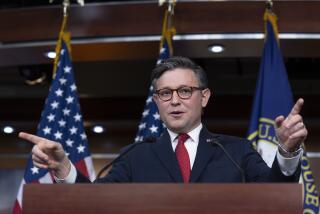Shutdown showed America’s dependence on the federal government

President Trump has repeatedly proposed gutting the federal bureaucracy, privatizing the air traffic control system and shrinking the federal workforce.
But by leading the country through the longest government shutdown in American history, he inadvertently revealed how intertwined the government is with millions of households, businesses and the entire U.S. economy.
The sharp rebuke he received from the public — and his decision Friday to reopen the government without winning concessions — could refresh a debate about the size and scale of government that has begun to frame the 2020 election.
The severe economic strain caused by the five-week shutdown forced small-government conservatives to break from Trump in a way they hadn’t before. They were overwhelmed with pleas from businesses and families caught in the middle of the shutdown, far beyond just the 800,000 federal employees who hadn’t been paid in a month.
“We cannot mess with people’s lives this way,” Sen. Lisa Murkowski (R-Alaska) said.
The air travel system bogged down. Tax refunds appeared in jeopardy. Parts of the federal court system were preparing to close. Food stamp benefits neared expiration, and the government was running out of money to pay rent for its own agencies, let alone low-income families who receive housing benefits.
Even though the shutdown affected less than a quarter of the government’s budget, White House officials said they believed it could have stalled the entire economy if it continued for much longer.
“The government touches so much of the economy that you don’t even realize,” said Melissa Kearney, an economics professor at the University of Maryland. “This brings into really sharp focus that the government is part of our daily economic lives in so many dimensions.”
The U.S. government is projected to spend roughly $4.5 trillion this year, a figure that represents 21% of the overall economy. The funding lapse affected just a small segment of that budget, and even though it broke the previous record for a funding lapse, it still only lasted for 35 days.
And while 800,000 federal employees weren’t paid for the month, they represent a tiny fraction of the overall workforce. But their role in the government proved integral enough to cause panic among major U.S. businesses and industries, who pleaded with policymakers in recent days to back down.
“Even though it was one-half of 1% of the workforce that was furloughed, those jobs provide the context for the whole economy,” said Matthew Slaughter, who was a member of the White House Council of Economic Advisers during the George W. Bush administration and is now dean of the Tuck School of Business at Dartmouth College.
Slaughter likened it to referees being pulled off the field during a professional football game. The referees often go unnoticed, but they set the rules and boundaries for much of the game, and without them the system eventually becomes unmanageable.
Republicans, particularly when they are in power, have long struggled to agree on the role of government in America. Tax-cut crusader Grover Norquist once called for shrinking the federal government down to a size that would make it possible to drown it in a “bathtub.”
In an interview Friday, however, Norquist said a government shutdown was never the way for conservatives to lead a serious debate about how much government is enough. He said a government shutdown doesn’t even shut down the government; it just cuts paychecks and causes inconveniences that are eventually going to be restored.
“You don’t cut the federal budget,” he said. “You reform the federal government to cost less.”
Both political parties are in the midst of a fierce debate about the proper size and scale of government. Trump has proposed deep cuts to agency budgets, particularly at the Environmental Protection Agency and others, but he has actually expanded the government’s budget markedly in the past two years.
The budget deficit — the gap between spending and tax revenue — is projected to near $1 trillion this year in part because the government keeps expanding, and in part because Trump has enacted significant tax cuts.
Democrats, meanwhile, are wrestling with how much bigger they want the government to grow. Some have called for dramatically expanding access to federal healthcare, college assistance programs and other benefits in a way that expands government spending even more.
Many parts of the government have been assembled in such a piecemeal way that there are redundancies and inconsistencies that both parties have struggled to fail to address. This has led to complaints of rampant waste and fraud, and inspectors general and other watchdogs routinely expose misappropriated spending.
But core parts of the government have become completely ingrained in the U.S. economy. The food stamp benefits that appeared set to expire in March reach close to 40 million Americans, and represent a large share of the income in certain communities.
Similarly, the Department of Housing and Urban Development covers the rent for many buildings full of elderly Americans, another program that was threatened. These programs frequently attract little public attention, in part because the prospect of the funds disappearing never seemed possible.
Trump signed into law a three-week spending bill, and raised the prospect on Friday of another shutdown in mid-February, an idea that many Republican lawmakers detest.
And that’s in part because key parts of the government that hadn’t elicited much thought until the shutdown were thrust into the spotlight in the past month. They could stay there for a while.
“Government is the invisible infrastructure that makes our society and our economy function smoothly,” said Robert Reischauer, a former director of the Congressional Budget Office. “And then it becomes more apparent when people can’t get their permit to fish in the waters off Alaska, or they can’t get their building permits, or Section 8 vouchers on which they depend.”
Paletta writes for the Washington Post.
More to Read
Start your day right
Sign up for Essential California for news, features and recommendations from the L.A. Times and beyond in your inbox six days a week.
You may occasionally receive promotional content from the Los Angeles Times.





